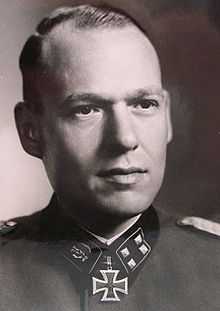Joachim Schubach
| Joachim Schubach | |
|---|---|
 | |
| Born |
17 September 1910 Hanover, Germany |
| Died |
5 November 1980 (aged 70) Hanover, Germany |
| Allegiance |
|
| Service/branch |
|
| Years of service | 1933–45 |
| Rank | Obersturmbannführer |
| Unit |
Leibstandarte SS Adolf Hitler 3rd SS Panzer Division Totenkopf |
| Battles/wars | World War II |
| Awards |
Knight's Cross of the Iron Cross Iron Cross 1st Class Iron Cross 2nd Class Eastern Front Medal 1941/42 Infantry Assault Badge in Silver Close Combat Clasp in Silver Wound Badge in Gold German Cross in Gold [1] |
Joachim Schubach (17 September 1910 – 5 November 1980) was an Obersturmbannführer (Lieutenant Colonel) in the Waffen SS during World War II and was awarded the Knight's Cross of the Iron Cross, which was awarded to recognize extreme battlefield bravery or successful military leadership by Nazi Germany during World War II.[2][3]
Early life
Joachim Schubach was born on 17 September 1910 in Hannover.[1][3]
He attended the Hindenburg Upper School and in 1933 he took part in a training program at the Empire Board of Trustees for youth. In 1933 he volunteered for the SS and was posted to the Leibstandarte SS Adolf Hitler stationed in Berlin.[2]
World War II
Schubach was still part of the SS Leibstandarte during the Polish Campaign. He was then transferred to the newly formed SS Totenkopf in October 1939.[2]
As a Hauptsturmführer (Captain) and company commander with the SS Totenkopf he took part in the Battle of France, being awarded the Iron Cross 2nd class fighting in France.[2][3]
In July 1941 he was awarded the Iron Cross 1st class at Demjansk during the invasion of the Soviet Union (Operation Barbarossa) and the German Cross in Gold in September 1942 at Lake Ilmen.[2][3]
In February 1943, the Totenkopf was converted into a Panzer Division and was part of the SS Panzer Corps then taking part in the Battle of Kharkov.[2]
Schubach now with the III. Battalion, 5th SS Panzer Grenadier Regiment, destroyed a strong Russian force, for which he was promoted to Sturmbannführer (Major) and awarded the Knight's Cross in April 1943, followed by the award of the Close Combat Clasp in Silver.[1][2][3]
Schubach was severely wounded – being blinded in both eyes – in November 1943 and remained in hospital until 1947.[1][2]
Post war
Joachim Schubach died of heart failure in his home town of Hanover on November 5, 1980.[1][2][3]
Awards
- Knight's Cross of the Iron Cross on 3 April 1943 as SS-Sturmbannführer and commander of the II./SS-Panzergrenadier-Regiment "Totenkopf"[4][Note 1]
Notes
References
- Citations
- Bibliography
- Fellgiebel, Walther-Peer (2000). Die Träger des Ritterkreuzes des Eisernen Kreuzes 1939–1945 – Die Inhaber der höchsten Auszeichnung des Zweiten Weltkrieges aller Wehrmachtteile [The Bearers of the Knight's Cross of the Iron Cross 1939–1945 — The Owners of the Highest Award of the Second World War of all Wehrmacht Branches] (in German). Friedberg, Germany: Podzun-Pallas. ISBN 978-3-7909-0284-6.
- Mitcham, Samuel W (2007). Retreat to the Reich : the German defeat in France, 1944. Mechanicsburg, PA: Stackpole Books. ISBN 978-0-8117-3384-7.
- Henschler Henri & Fay Will, Armor Battles of the Waffen-SS, 1943-45 Stackpole Books, 2003. ISBN 0-8117-2905-2.
- Scherzer, Veit (2007). Die Ritterkreuzträger 1939–1945 Die Inhaber des Ritterkreuzes des Eisernen Kreuzes 1939 von Heer, Luftwaffe, Kriegsmarine, Waffen-SS, Volkssturm sowie mit Deutschland verbündeter Streitkräfte nach den Unterlagen des Bundesarchives [The Knight's Cross Bearers 1939–1945 The Holders of the Knight's Cross of the Iron Cross 1939 by Army, Air Force, Navy, Waffen-SS, Volkssturm and Allied Forces with Germany According to the Documents of the Federal Archives] (in German). Jena, Germany: Scherzers Miltaer-Verlag. ISBN 978-3-938845-17-2.
| |||||||||||||||||||||||||||||||||||||||||||||||||||||||||||||||||||||
